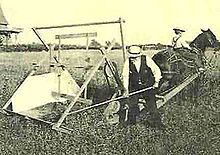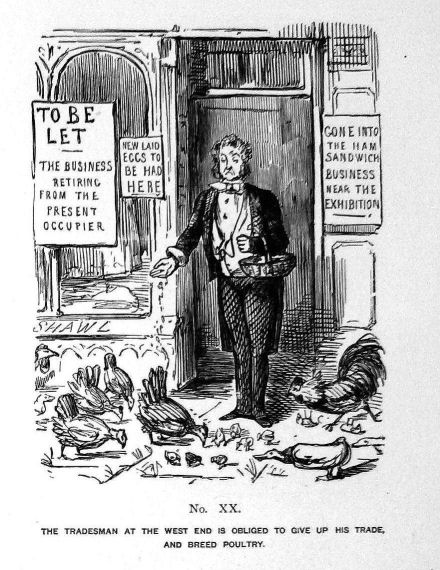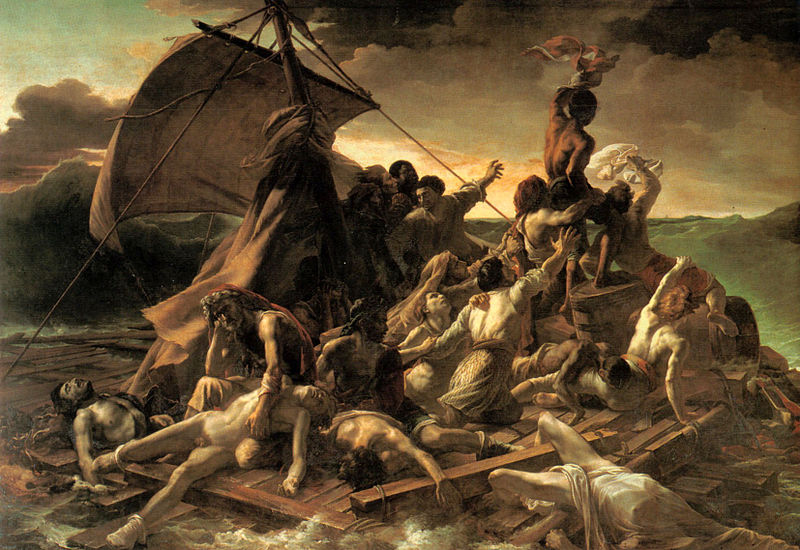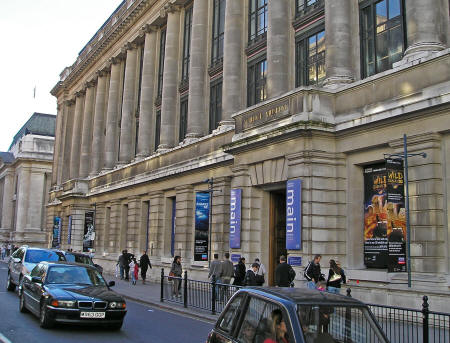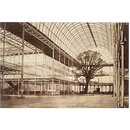The Great Exhibition is unique among world fairs in housing the contributions of all nations under one roof, the Crystal Palace. This is not to say that nations did not approach the challenge of providing exhibits in widely differing manners, however, and America's contribution was in many ways unique.
 |
| The American area in the Crystal Palace |
America's Great Exhibition effort did not get off to a good start. With the exception of the loan of a ship to transport exhibits to England, American exhibitors received no official government sponsorship, in contrast to every other foreign exhibitor at the fair [1]. When the Lawrence arrived in England, it was discovered that there were not even sufficient funds to unload and transport the exhibits to London. George Peabody, an American banker living on London, eventually rescued the situation and provided the $15,000 needed for transportation, the arrangement of the exhibits and the decoration of the American space in the Crystal Palace. Worse still, with high expectations as to the quantity and quality of its exhibits, America requested, and was granted, a greater floor area than any other foreign nation except France, a far greater area than their exhibits warranted.
There were other firearms and locks, clocks, a cotton-gin, and oddities such as a "patent double grand piano, upon which four performers at a time can execute compositions arranged for eight hands and two pianos" and a model of a floating church built for the Churchman's Missionary Association in Philadelphia [2].
Samuel Colt revolver. Source: wikipedia
No American paintings were hung at the Exhibition, and American sculpture was chiefly represented by Hiram Power's Greek Slave and Peter Stephenson's Dying Indian.
Initial reaction to the American exhibits was less than enthusiastic. Much fun was made of the sparsity of exhibits for the space assigned to America, with Punch going as far to suggest that the "American Non-Exhibitors" should provide lodgings in the empty part of their area:
Changing opinion
The final reckoning
____________________________
Samuel Colt revolver. Source: wikipedia
No American paintings were hung at the Exhibition, and American sculpture was chiefly represented by Hiram Power's Greek Slave and Peter Stephenson's Dying Indian.
Initial reaction to the American exhibits was less than enthusiastic. Much fun was made of the sparsity of exhibits for the space assigned to America, with Punch going as far to suggest that the "American Non-Exhibitors" should provide lodgings in the empty part of their area:
"By packing up the American articles a little closer, by displaying COLT'S revolvers over the soap, and piling up the Cincinnati pickles on top of the Virginia honey, we shall concentrate all the treasures of American art and manufacture into a very few square feet, and beds may be made to accommodate several hundreds in the space flamed for, but not one-quarter filled by, the products of United States industry.
We would proposed, therefore, that the Yankee Commissioners be empowered to advertise America as affording accommodation to those who wish to spend a week visiting the Great Exhibition...By an arrangement with the Commissioners, whose duties must be rather light, breakfast could no doubt be provided for the lodgers before starting on their rounds; and the sign of the Spread Eagle would be an appropriate one to adopt; for the hotel department of the speculation" [3].
Punch's acid suggestion wasn't in fact far off the mark. Some of the space was given up for seating of foot-weary visitors. Punch's wit was also directed at the Greek Slave, combining a dig at the lack of exhibits with disdain for American slavery:
"Why not have sent us some choice specimens of slaves? We have the Greek captive in dead stone - why not the Virginia slave in living ebony?".
The piece was accompanied by a cartoon on the subject (right), mimicking the Greek Slave [4].
In contrast to the nearby silks and jewels of India, for example, the American exhibits lacked excitement. The London Morning Chronicle was typical of the British press in concluding that the American exhibit was neither what had been expected of the United States, nor an adequate representation of her capabilities[5].
Yet the tide of opinion changed through the course of the Exhibition. By the end of the Exhibition, the Times was declaring that "Great Britain has received more useful ideas, and more ingenious inventions, from the United States, through the exhibition, than from all other sources"[6]. Why did contemporary opinion change so markedly?
The answer in large part lies with the discovery of the utility of several of the American exhibits. Agricultural implements provides one such example. The McCormick reaper, in particular, may have looked huge and ungainly on display, but proved to far exceed the speed, efficiency and endurance of all competitors. One British commissioner wrote of the "introduction of the most important addition to farming machinery that has been invented since the threshing machine first took the place of the flail"[7].
 |
| Newell's Permutation Lock and Key Ilustrated London News (July-August 1851) |
The lock designed by the New York firm of Day and Newell provides another example. Representing the firm, Mr Hobbs, convinced of the fallibility of the leading English locks, demonstrated to large public audiences that it was possible to pick them. The Bramah lock had been on display in the Bramah's Piccadilly store window for forty years with the offer of a 200 guineas reward to anyone who could pick it. Hobbs did so in less than a month, whilst British locksmiths conspicuously failed to master the American lock[8].
Colt revolvers and Robbins and Lawrence rifle were also found to be clearly superior to all comparable firearms. Even Punch acknowledged American achievements, running the following verse in the very next addition from that in which it had suggested America offer its excess floor space as lodgings:
YANKEE DOODLE sent to Town
His goods for exhibition;
Everybody ran him down,
And laugh'd at his position;
They thought him all the world behind;
A goney, muff or noodle;
Laugh on, good people - never mind-
Say quiet YANKEE DOODLE...
Your gunsmiths of their skill may crack,
But that again don't mention;
I guess that COLTS' revolvers whack
Their very first invention.
By YANKEE DOODLE, too, you're beat
Downright in agriculture,
With his machine for reaping wheat
Chaw'd up as by a vulture...
You also fancied, in your pride,
Which truly is tarnation,
Them British locks of your defied
The rogues of all creation;
But CHUBBS' and BRAMAH'S HOBBS he picked,
And you must now be viewed all
As having been completely licked
by glorious YANKEE DOODLE...[9]
The final reckoning
America's contribution to the exhibition was perhaps best summed up by Liberal Republican, Horace Greeley, who acted as American juror on the exhibition award committee:
"Our share in the Exhibition was creditable to us as a nation not yet a century old, situated three to five thousand miles from London; it embraced many articles of practical value, though uncouth in form and utterly unattractive to the mere sight-seer; other nations will profit by it and we shall lose no credit; but it fell far short of what it might have been, and did not fairly exhibit the progress and present condition of the Useful Arts in this country. We can and must do better next time, and that without calling on the Federal Treasury to pay a dollar of the expense" [10].
America's display was embarrassingly sparse and certainly bore no comparison to the visual feasts produced by colonies such as India with its fabrics and jewels. Yet with no government backing, America had produced a display that contained a number of valuable contributions to technology in a variety of fields. It had demonstrated that America, with its ever increasing population and rapid improvements in technology, was (or, if not quite yet, certainly would be) a force to be reckoned with.
| Notes: |
[1] Curti, Merli. 'America at the World Fairs, 1851-1893', The American Historical Review, Vol. 55, No. 4 (July 1950). Pg 837
[2] Official Catalogue Vol. 5, Pgs 1431-1469
[3] Punch XX (1851). Quoted in Cunliffe, Marcus. 'America at the Great Exhibition of 1851', American Quarterly, Vol 3. No 2. (Summer 1951). Pg 120.
[4] Ibid
[5] London Morning Chronicle, 17 May 185. Quoted in 'America at the World Fairs', Pg 838
[6] Quoted Ibid. Pg 840
[7] 'America at the Great Exhibition'. Pg 124
[8] Ibid
[9] Punch XXI (1851)
[10'America at the Great Exhibition'. Pg 126
